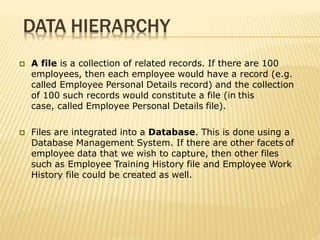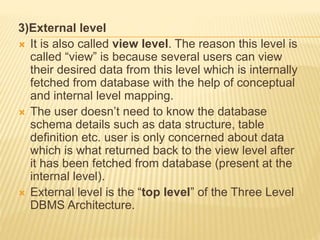Architecture of dbms
- 1. ARCHITECTURE OF DBMS & DATA MODELS PRSENTED BY :- MRS. SURKHAB SHELLY ASSISTANT PROFESSOR IN COMP. SCI.
- 2. DATA HIERARCHY Data Hierarchy refers to the systematic organization of data, often in a hierarchical form. A computer system organizes data in a hierarchy that starts with bits and bytes and progresses to fields, records, files, and databases. A bit represents the smallest unit of data a computer can handle. A group of bits, called a byte, represents a single character, which can be a letter, a number, or another symbol Data organization involves fields, records, files and so on. A field holds a single fact - Consider a date field, e.g. "September 19, 2004". This can be treated as a single date field (eg birthdate), or 3 fields, namely, month, day of month and year. A record a collection of related fields. An Employee record may contain a name field(s), address fields, birthdate field
- 3. DATA HIERARCHY A file is a collection of related records. If there are 100 employees, then each employee would have a record (e.g. called Employee Personal Details record) and the collection of 100 such records would constitute a file (in this case, called Employee Personal Details file). Files are integrated into a Database. This is done using a Database Management System. If there are other facets of employee data that we wish to capture, then other files such as Employee Training History file and Employee Work History file could be created as well.
- 4. LEVELS OF DATABASE MANAGEMENT SYSTEM This architecture has three levels: 1. External level 2. Conceptual level 3. Internal level
- 5. 1)Internal level This level is also known as physical level. This level describes how the data is actually stored in the storage devices. This level is also responsible for allocating space to the data. This is the lowest level of the architecture It also typically describes the record layout of files and type of files (hash, b-tree, flat).
- 6. 2)Conceptual level It is also called logical level. The whole design of the database such as relationship among data, schema of data etc. are described in this level. It also describes what kind of data is to be stored in the database. Database constraints and security are also implemented in this level of architecture. This level is maintained by DBA (database administrator
- 7. 3)External level It is also called view level. The reason this level is called “view” is because several users can view their desired data from this level which is internally fetched from database with the help of conceptual and internal level mapping. The user doesn’t need to know the database schema details such as data structure, table definition etc. user is only concerned about data which is what returned back to the view level after it has been fetched from database (present at the internal level). External level is the “top level” of the Three Level DBMS Architecture.
- 8. Item # Item- name Price I1 Cake 50.00 I2 Bread 9.00 I3 Biscuits 6.00 I4 Snacks 16.00 1.Relational DataModel Supp# Supp-name S1 Britannia S2 New Bakers Supp# Item# Qty- Supplie d S1 I2 20 S1 I3 25 S1 I4 10 S2 I1 5 S2 I3 10 Table : Items Table : Suppliers Table : Shipments 1.RELATIONAL DATA MODEL: In relational data model, the data is stored in the form of tables (i.e. rows ad columns). These tables are calledrelations. The user of the relational databasesystem may insert new tuples, delete tuples, and modifytuples. DATA MODELS
- 9. RELATIONAL MODEL The data is stored in two-dimensional tables (rows and columns). The data is manipulated based on the relational theory of mathematics. Properties of Relational Tables: Values Are Atomic EValues Are of the Same Kind The Sequence ach Row is Unique Column of Columns is Insignificant The Sequence of Rows is Insignificant Each Column Has a Unique Name A relational database management system (RDBMS) is a DBMS that is based on the relational model. Some well known RDBMS: IBM DB2, Informix, Microsoft SQL Server, Microsoft Visul Foxpro, MySQL, Oracle, Sybase, Teradata, Microsoft Access
- 10. I2 2. NETWORK DATA MODEL 2. NETWORK DATA MODEL: •The network data model differs from the relational model.In this model data is represented by connection of records and relationships among data are represented by links. •Records are organized asgraphs. •As there is no definite path defined for retrieval of data, the number of links is very large and thus network databases are complex, slow and difficult to implement. •Relationship between records is expressed in the form of pointers or links. •In this model each parents can have multiple children and children can also have multiple parents. •It support many to many relationships.
- 11. S1 I3 3. HIERARCHICAL DATA MODEL 3. HIERARCHICAL DATA MODEL: •Data is represented by collection of records and relationships among data by links. Records are organized as trees rather than graphs. •Represents relationship among its records through parent child relationships. •This model supports one-to-one and one-to-many relationships.
- 12. Hierarchical Data Model Network Data Model Relational Data Model 1. Relationship between records is of the parent child type. 1. Relationship between records is expressed in the form of pointers or links. 1.Relationship between records is represented by a relation that contains a key for each record involved in the relationship. 2. Many to many relationship cannot be expressed in this model 2. Many to many relationship can also be implemented in this model 2. Many to many relationship can be easily implemented. 3. It is a simple, straightforward and natural method of implementing record relationships. 3. Record relationship implementation is quite complex due to the use of pointers. 3. Relationship implementation is very easy through the use of a key or composite key field. 4. This type of model is useful only when there is some hierarchical character in the database. 4. Network model is useful for representing such records which have many to many relationships. 4. Relational model is useful for representing most of the real world objects and relationships among them. 5. Searching for a record is very difficult since one can retrieve a child only after going through its parent record. 5. Searching for a record is easy since there are multiple access paths to a data element. 5. A unique, indexed key field is used to search for a data element. 6. In Hierarchical model record relations are physical. 6.In Network model record relations are physical. 6. Relational model does not maintain physical connection among records, data is organized logically in the form of rows and columns and stored in table. 7. During updation or deletion process, chances of data inconsistency is involved. 7. No problem of inconsistency exists in Network model. 7. Data integrity maintaining methods like Normalization process are adopted for













